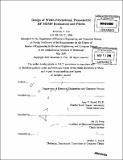| dc.contributor.advisor | Amy E. Duwel. | en_US |
| dc.contributor.author | Cox, Jonathan A | en_US |
| dc.contributor.other | Massachusetts Institute of Technology. Dept. of Electrical Engineering and Computer Science. | en_US |
| dc.date.accessioned | 2009-06-30T16:56:00Z | |
| dc.date.available | 2009-06-30T16:56:00Z | |
| dc.date.copyright | 2007 | en_US |
| dc.date.issued | 2007 | en_US |
| dc.identifier.uri | http://hdl.handle.net/1721.1/45987 | |
| dc.description | Thesis (M. Eng.)--Massachusetts Institute of Technology, Dept. of Electrical Engineering and Computer Science, 2007. | en_US |
| dc.description | Includes bibliographical references (p. 119-121). | en_US |
| dc.description.abstract | Existing width-extensional, piezoelectric resonators (LBARs) suffer from high motional resistance and susceptibility to manufacturing disorder. Attempts to lower motional resistance by connecting many LBARs electrically in parallel fail because such schemes are highly susceptible to the disorder inherent in the fabrication process. The manufacturing precision, not the minimum feature size, presently limits the maximum frequency for which a resonator or filter array can be fabricated. However, the effect of disorder in a group of resonators can be reduced with mechanical coupling. Therefore, we present a novel approach that is disorder tolerant, allowing for the fabrication of higher frequency, lower impedance LBAR-based resonators and filters. This novel resonator defeats the aspect ratio limitations imposed by the Poisson effect through stress-relieving slits. By etching narrow slits in a long bar, it is constrained to act as a single LBAR-without the spurious modes which would otherwise result. In addition, the admittance of the new array scales well with the number of unit cells, permitting the length of the array to be extended in one or two dimensions until the motional resistance is reduced to an adequate level. Finite element analysis techniques for disorder simulation and filter design are explored. Radiated acoustic power (anchor loss) is analyzed with finite element simulations with absorbing boundaries. Finally, a thorough discussion of filter design with the new resonator array, as well as a comparison of various filter topologies, is conducted. | en_US |
| dc.description.statementofresponsibility | by Jonathan A. Cox. | en_US |
| dc.format.extent | 121 p. | en_US |
| dc.language.iso | eng | en_US |
| dc.publisher | Massachusetts Institute of Technology | en_US |
| dc.rights | M.I.T. theses are protected by
copyright. They may be viewed from this source for any purpose, but
reproduction or distribution in any format is prohibited without written
permission. See provided URL for inquiries about permission. | en_US |
| dc.rights.uri | http://dspace.mit.edu/handle/1721.1/7582 | en_US |
| dc.subject | Electrical Engineering and Computer Science. | en_US |
| dc.title | Design of width-extensional, piezoelectric RF MEMS resonators and filters | en_US |
| dc.title.alternative | LBAR RF MEMS resonators and filters | en_US |
| dc.type | Thesis | en_US |
| dc.description.degree | M.Eng. | en_US |
| dc.contributor.department | Massachusetts Institute of Technology. Department of Electrical Engineering and Computer Science | |
| dc.identifier.oclc | 341702851 | en_US |
